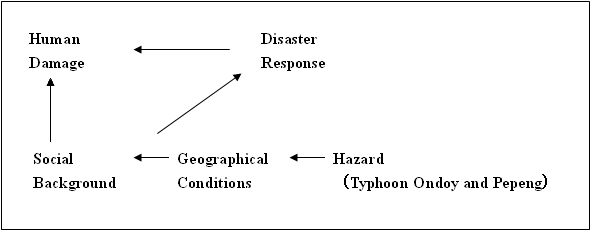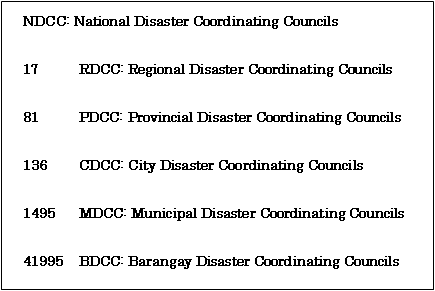Research Report on 2009 Floods and Landslides Disasters Caused by Typhoons 16(Ondoy), 17(Pepeng) and 18(Sante) in the Philippines
8.Social Background and Disaster Responses in the Philippines
1. Introduction
This paper summarizes the findings of research into the disaster response system of the Philippines, which was conducted by an NIED research group after the destruction caused by Typhoons Ondoy and Pepeng between November 23 and December 3, 2009.
First, this paper tries to clarify the overall disaster response situation after presenting an overview of the social background in the Philippines. Specifically, it outlines the structures of the NDCC (National Disaster Coordinating Council), CAR-RDCC (Regional Disaster Coordinating Council) and Baguio City-CDCC (CDCC: City Disaster Coordinating Council) based on data gathered in interviews. To investigate the responses of NGOs to the disasters, we also conducted an interview with the PNRC (Philippine National Red Cross), the outcome of which will appear in the printed version.

Fig. 1 Social Background, Disaster Response, and Human Damage Relations
2. Framework
This report aims to present an outline of research outcomes based on the framework of Fig. 1, which illustrates the relationships between geophysical conditions, social backgrounds, disaster responses, and human damage. This framework was developed based on the author's study of Hurricane Katrina in December 2005. This section indicates the geographical conditions and social background.
2.1. Overview of the Philippines: Geographical and Social Background
The Philippines is prone to many natural disasters including earthquakes, volcano eruptions, tropical cyclones/typhoons and floods. This situation is closely related to the country's geographical and social situation. In geophysical terms, the Philippines is located on a part of the Pacific Belt zone that is easily affected tropical cyclones. With regard to social factors, some experts have identified a relationship between poverty and vulnerability to natural disasters. It also could be said that the typhoon Onody and Pepeng disasters closely linked to the urbanization of low-lying areas in NCR and in mountainside areas of Baguio City that are prone to landslides. On the other hand, the Philippines is experiencing a high level of population growth. For example, the annual growth rate was 2.36% from 1995 to 2000 and 2.04% from 2000 to 2007, as shown in Table 1. Tables 1, 2 and 3 show the population growth of each area (NCR, CAR, etc.). In this study, the 3.86% growth of Tagigu city in NCR and the 2.50% growth of Baguio city from 2000 to 2007 should be taken into consideration when analyzing the disaster effects and recovery processes.
With reference to socio-economic factors, Table 4 shows the income and poverty ratio statistics of these areas for 2002-2003. This clearly shows that the poverty ratios of NCR and Benguet Province are lower than those of the country as a whole. This detail will be explained in the next report based on HDI (Human Development Index) or related indicators.
| Region/Province | Total Population | Annual Population Growth Rate | |
|---|---|---|---|
| 1-Aug-2007 | 2000-2007 | 1995-2000 | |
| Philippines | 88,574,614 | 2.04 | 2.36 |
| National Capital Region | 11,553,427 | 2.11 | 1.06 |
| Cordillera Administrative Region | 1,520,743 | 1.50 | 1.82 |
| Region/Province/Highly Urbanized City | Total Population | Annual Population Growth Rate | |
|---|---|---|---|
| 1-Aug-2007 | 2000-2007 | 1995-2000 | |
| Cordillera Administrative Region | 1,520,743 | 1.50 | 1.82 |
| Benguet | 372,533 | 1.68 | 1.09 |
| Baguio City | 301,926 | 2.50 | 2.31 |
| Region/Province/Highly Urbanized City | Total Population | Annual Population Growth Rate | |
|---|---|---|---|
| 1-Aug-2007 | 2000-2007 | 1995-2000 | |
| National Capital Region | 11,553,427 | 2.11 | 1.06 |
| City of Manila | 1,660,714 | 0.68 | -0.97 |
| City of Marikina | 424,610 | 1.14 | 1.96 |
| City of Pasig | 617,301 | 2.80 | 1.50 |
| Quezon City | 2,679,450 | 2.92 | 1.92 |
| City of Makati | 510,383 | 1.91 | -1.80 |
| Pasay City | 403,064 | 1.77 | -2.97 |
| Taguig City | 613,343 | 3.82 | 4.45 |
| Area | Annual Income per Person (Peso) | Poverty ratio(Under the minimum needs condition for daily life) |
|---|---|---|
| Philippines | 19676 | 28.4% |
| NCR | 44357 | 5.7% |
| CAR | 17563 | 40.4% |
| Benguet | 20735 | 14.1% |
2.2. Natural Disaster Risk in the Philippines
(1) Risk of mortality due to typhoons
It is said that between five and seven of every twenty of typhoon disasters in the Philippines are critical. According to ESCAP/ISDR, "In Japan, 22.5 million people are exposed annually to typhoons/cyclones, while in Philippines 16 million are exposed. But the mortality risk in the Philippines is 7 times higher than in Japan" (ESCAP/ISDR 2009:2). This shows that the Philippines is more vulnerable to typhoons.
(2) Historical background of natural disasters - Typhoon disasters in the Philippines
The report indicates the previous history of typhoon disasters before Typhoons Ondoy and Pepeng in 2009. Deforestation makes a particularly large contribution to typhoon disasters in the Philippines, and has exacerbated these disasters for a number of decades. For example, river floods caused by a typhoon in Samar Island in 1989 caused over 100 causalities, Ormok city in Laite Island was affected by flooding that caused over 8000 deaths as a result of a typhoon in 1991, and a combination of flooding and landslides in Luzon Island in 2004 reportedly caused approximately 1500 casualties.
3. Disaster Response in the Philippines
Since there is a very high risk of natural disasters in the Philippines, many disaster response organizations such as the UN, governmental, and international and national NGOs have been working there as a result of previous natural disasters. This section explains the activities of disaster-related national organizations.
3.1. Administrative units in the Philippines

Fig.2 Administrative divisions of the Philippines
The notion of administrative units in the Philippine is crucial for gaining a clear overview of the disaster response situation in the Philippines. The present administrative units date back to a 1991 government act, where various administrative functions such as public works, education, the pricing of agricultural goods and social welfare were devolved from central to local government. The administrative hierarchy of the Philippines is now as follows:
The land of the Philippines is divided into three blocks - Luzon, Visaya, and Mindanao. These are subdivided into seventeen regions. Each region consists of a number of provinces, and the provinces include cities and municipalities. The cities and municipalities consist of barangays, which are the smallest administrative divisions. Several cities have become highly urbanized and are classified as independent provincial administrative units. For examples, Luzon has 6 regions, 1 administrative region, and 1 NCR (national capital region) as shown in Fig. 2. These are the Ilocos Region (Region I), the Cagayan Valley (Region II), Central Luzon (Region III), Calabarzon (Region IV-A), Mimaropa (Region IV-B), the Bicol Region (Region V), the Cordillera Administrative Region (CAR), and the National Capital Region (NCR). Baguio is a highly urbanized city in the Cordillera administrative region, to which Benguet province also belongs.
3.2. Basic Disaster Response Systems in the Philippines

Fig. 3: Networks of the DCC (Disaster Coordinating Council) (Presentation Documents delivered by Ms. Nelia S. Tabliago)
Disaster responses consist of several stages shown as Fig.3. At first, there are emergency management systems from the level of barangay. If disaster overwhelmed the barangay level, municipal level like MDCC would response and if it overwhelmed the municipal level, CDCC or PDCC would react. The disaster is so high and once it overwhelmed regional level, NDCC would respond. The NDCC conduct disaster response work by doing collaboration with every level of DCCs and coordination with every related national organization under the direct supervision from the president of the Philippines.
3.3. Legal Aspect
Presidential Decree No. 1566 (PD No. 1566, June 11, 1978) provided for the strengthening of the Philippines' disaster control capabilities and the establishment of a nationwide community disaster preparedness program as a legal basis for disaster management systems in the Philippines.
Among the salient provisions of PD 1566 are the following (NDCC 2010):
- State policy on self-reliance among local officials and their constituents in responding to disasters or emergencies;
- Organization of disaster coordinating councils from the national down to the municipal level;
- Statement of duties and responsibilities of the National Disaster Coordinating Council (NDCC), RDCC and LDCCs;
- Preparation of a National Calamities and Disaster Preparedness Plan (NCDPP) by OCD and implementation of plans by NDCC member-agencies;
- Conduct of periodic drills and exercises; and
- Authority for government units to program their funds for disaster preparedness activities in addition to the 2% calamity fund as provided for in PD 474 (amended by RA 8185).
PD 1566 also assists the coordinating and supervising works of DCCs as disaster response functions at each level.
3.4. Declaration of Policies and Legal Authority of NDCC
PD No.1566 (June 11, 1978) section1, declaration of policies consists of the followings:
- Responsibility for leadership rests on local chief executives
- Self reliance, self help, and mutual assistance.
(Each political and administrative subdivision of the country shall utilize all available resources in the area before asking for assistance from neighboring entities or higher authority.) - Primary responsibility rests on the government agencies in the affected areas in coordination with the people themselves.
- All government departments, bureaus, agencies and instrumentalities to have documented DM plans.
- National government exists to support the local governments.
In addition, PD1566 define the legal authority of National Disaster Coordinating Council (NDCC) as strengthening the Philippine disaster control capability and establishing a national program of community disaster preparedness.
3.5. Roles, organization, and members of National Disaster Coordinating Council (NDCC)
The establishment of NDCC is based on the PD1566, Section2. NDCC shall play a key role on disaster response such as:
- Highest policy making, coordinating and supervising body at the national level for disaster management in the country.
- Advises the president on the status of national disaster preparedness & management plans.
- It recommends to the president the declaration of state of calamity and release of national calamity fund as needed.
Concerning the organization and members of NDCC, a secretary of National Defense is working as a chairman and other secretaries of 18 governmental agencies are involved as members, such as a chief of staff of AFP (Armed Forces of the Philippines), a secretary general of PNRC (Philippine National Red Cross), and a director of Philippine Information Agency. An administrator of office of civil defense is serving for NDCC as a member and an executive officer.
Basically, each level of DCC consists of the same structure with NDCC at local level and has same responsibilities for each level of administrative unit.
4. Conclusion
This report shows a part of social backgrounds and disaster response systems of the Philippines as backgrounds of Typhoon Ondoy and Pepeng disasters. This detailed report shall be published by researching and analyzing this issue more deeply with reviewing the data which the research group collected in the Philippine within the year.
References for this chapter- National Statistics Office (2009) 2007 Census of Population(http://www.census.gov.ph/ 2010.02.18)
- Presentation Documents delivered by Ms.Nelia S.Tabliago at NDCC Meeting in Manila Metropolitan Area, on Dec. 2nd, 2009
- The World Bank・Pacific Consultants (2005) Natural Disaster Risk Management in the Philippines : Reducing Vulnerability Follow-On Study Final Report
- The World Bank, NDCC (2003) Natural Disaster Risk Management in the Philippines: Enhancing Poverty Alleviation through Disaster Reduction
- United Nations ESCAP/ISDR (2009) The Asia-Pacific Disaster Report: Securing Development in the Face of a Changing Climate A Joint ESCAP-UNISDR Publication
[ DIL TOP page | TOP page ]

